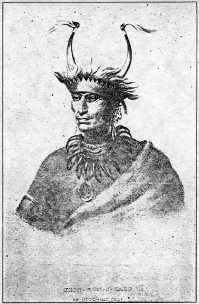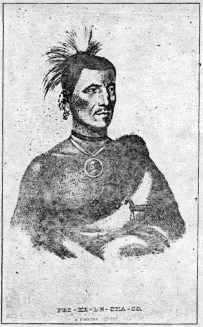|
8 |
|

|
8 |
|

Chon-moni-case or Shau-mone-kusse, (called by the white fur-traders Ietan) is the most noted chief of the Otoe tribe in the early American period. He was one of those prominent at the great council of the Otoe tribe with Major Long Oct. 3, 1819, at their camp about six miles above Florence, near Fort Lisa. He was then a young man and this portrait as (sic) made at that period. Later he became a head chief. He was killed April 28, 1837, in a fight with young Otoes who had run away with one of his wives. Moses Merrill, first missionary to the Otoe, saw the fight and wrote the story of it in his diary. The great Otoe village where Ietan ruled was three miles southeast of the present village of Yutan. There are many remains of this village still visible. They were photographed by the editor of this magazine in 1919. Yutan was named in honor of this Otoe chief.
|
|
9 |
Nebraska Indians Journey to Paris.
About 1714 the grand chief of the Otoptata
descended the Mississippi to meet Bienville, and died at Biloxi.
Ten years later another chief of this nation accompanied M. De
Bourmont to Paris. The nations on the Missouri had designed to
send to France ten delegates, --one Otoptata, four Osage and five
Missouri, one of whom was a young woman. But the Council of the
Colony, for reasons of economy, held back five and permitted to go
only the young Missouri woman, one Otoptata and one Osage, one
Missouri, one Illinois and Chicagou, ambassador of the
Metchigamias.
The (Indian) envoys arrived at Paris on
September 20, 1725, and were received by the duke of Bourbon, the
duchess of Orleans and the directors of the Company of the Indies.
They were then presented to the king by Rev. Father de Beaubois
(S. J.) who delivered to Louis XV a necklace of friendship sent by
Mamantonense, chief of the Metchigamias, Kaokias and
Tamarois15 with a speech16 given by
Chicagou17. This orator had, a few days before, wished
the duchess of Orleans "to be fruitful in great warriors like the
ancestors of your husband and yourself."
These Indians from Louisiana were, for sometime,
all the rage at Paris. They received beautiful blue suits with
gold lace. At the Bois de Bolougne, before the court, they hunted
deer "in their own style, that is by chasing" and they gave war
dances at the opera and the Italian theatre. If we may believe
Bossu one of these Indian envoys recalled thirty years afterward
the perfumes so extravagantly used by Paris ladies and declared
that "they smelled like alligators."
Nebraska Orator at Paris.
One of the three representatives of the
Otoptatas, Osages and Missouris, we do not know which, died on the
journey, and one of his companions pronounced an oration for the
deceased in the name of all the Indians of the Missouri. Here are
two charming passages from the translation made in prose and verse
of his address before the king:
"Twelve whole moons have passed since we left
our land (that is, Nebraska, Missouri and Iowa,) November, 1724 to
appear here. One of our chiefs is dead on the way, the others
gave. up, or remained on the seashore, (that is, in New Or-
|
10 |
|
leans.) We are ashamed to see our plain speech. We bring with
us furs and the work of our squaws. You will not think them of
much worth , since you have in abundance, things so much more
beautiful, but everything was lost in the first ship which was to
bring us across18---we cannot wonder enough at the
beautiful things which we see every day. We are very happy in the
treatment given us since we arrived in this land; we had not been
so before we arrived here19. The tribes represent to
you:
1. Not to abandon them and they ask the French
as much to keep friendship as to provide for their needs.
2. That they have never had any one to teach
them to pray save only a white collar20 who came to
them a little time ago, whom they are happy to have and beseech
you to send others.
3. They beg you to send us back entrusted with
your message and they will look on all upon this side (the great
water) in order that they may see you again.
4. That the French having made known to us all,
that you think in all this country, and that the stores which are
here are from you. We are in your hands give to our bodies.
(Sic).
Verses in Honor.
So much eloquence drove an anonymous versemaker
to 'Put in rhyme the prose of the Indians of the
Missouri.21
|
|
11 |
"Missouri Princess".
As for the "Missouri Princess"--she was baptized at (the church) of Notre Dame of Paris, then married to Sergeant Dubois, one of the companions of Bourmont during his journey of 1724 to the Padowkas. Dubois scarcely reaped the reward of his promotion to be commissioned officer and his appointment as King's interpreter for the nation of the Illinois--which he received on the occasion of his marriage, for he perished at the massacre of the garrison of the fort of Orleans of the Missouri. If one may believe Dumont Madame Dubois caused the assassination of her husband, but that statement seems to us hardly probable. In any event she married again a little later a captain of militia of Illinois named Marin. Bossu saw at Paris in 1751 two children of the "Princess."22
Ancient Home of Otoe Tribe.
At the time which concerns us the Oto lived on the south bank of the river Platte, most of the time, it seems, near the point where the course of that river turns sharply in the southern direction. It is difficult to locate the point with greater certainty, first, because the Indians lived in a number of villages23 and during the 18th century drew, little by little, closer to the Missouri river, and second, because the explorers who give the number of leagues (figures varying) which separate the Oto from the Missouri, have failed for the most part to inform us whether they reckoned the distances by the direct trail across country or by following the great bend of the river.24
The Pani--Maha.
The exact location of the Pani-Maha seems a
little more difficult. These Indians, who certainly played a very
important role in the massacre of the Spaniards, lived in 1720
north of the river Platte, along the different branches of the
river 'Which was generally given the name "River of the
Pani-Maha,"" but later received the name of Loup which it still
bears.25
* See notes by Addison E. Sheldon on pages 29-31.
|
12 |
|

Pes-ke-le-cha-co
Was a noted Pawnee chief in the early period of the 19th century. He was one of the chiefs chosen to visit Washington some time prior to 1825 and confer with the president. His portrait was painted at that time. On his return he became one of the strong advocates of friendly relations with the white men in the councils of the Pawnee nation. He had seen the great cities filled with white people, their great guns, ships and factories and he never tired of relating the sights of this visit. In 1826 a war party of Osage raided the Pawnee villages. Pes-ke-le-cha-co killed an Osage. He rushed forward to lay his hand on the dead warrior--one of the highest honors in war. In the struggle to prevent this Pes-ke-le-cha-co was slain. His deeds were long related around the camp fires of the Pawnee nation.
|
|
13 |
The Pani-Maha were evidently part of the
great nation of Pani (Pawnee) but seem to have formed a branch
somewhat distinct from the other tribes, of whom the nearest was
the Grand Pani sometimes called simply Pani--and the Pani-Pique,
often formerly called White Pani. These latter were more friendly
to the Spaniards than to the French. Nothing forbids conceding
(with the Handbook of American Indians) that the Pani-Maha were
the direct ancestors of the Pani-Loup, Loup or Skidi26
who lived in the same region sixty years later. The independence
of the Pani-Maha, in opposition to the other Pani, and the complex
formation of their name might well arise from a fusion, common
enough with Indians, --between one tribe of Pani and a group of
Maha27--which nation for so long a time wandered along
the Missouri and one tribe of which was located at the beginning
of the 18th century near the Oto.
The Loup28, in any event, had without
doubt forgotten their double (surmised) parentage, for they were
later often at war with the white Pani and the Maha.
Spanish Officer's Note Book.
Let us now proceed to the history of the
Spanish Expedition. And here, at the start, are the last leaves of
the note book of the journey by a Spanish officer. These are the
only records, unfortunately, which the Indians brought to M. de
Boisbriant, commandant of the province of Illinois:
Translation of a leaf from a journal in Spanish, found at the
defeat of a detachment of that nation by the
Otoptata.29
(On the margin--"Also written Ouatotchata").
"The trails which we find lead us to a place
where we believe we shall get information of a band which, by all
appearances, is not very far distant from some village. We resolve
to camp in order to see what there is for us to do.
© 2000, 2001 for NEGenWeb Project by Ted & Carole Miller